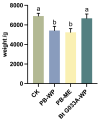Comparative Control of Phyllotreta striolata: Growth-Inhibiting Effects of Chemical Insecticides Versus the Green Advantages of a Biopesticide
- PMID: 40558982
- PMCID: PMC12193207
- DOI: 10.3390/insects16060552
Comparative Control of Phyllotreta striolata: Growth-Inhibiting Effects of Chemical Insecticides Versus the Green Advantages of a Biopesticide
Abstract
Phyllotreta striolata is a major pest of Brassica chinensis, with chemical pesticides being the primary method for pest control. However, their negative impact on crop growth and environmental risks have prompted the search for low-toxicity, environmentally friendly alternatives. This study systematically evaluates the control effectiveness of two commonly used chemical pesticides, Zu Jia® and Jie Tiao®, along with their impact on the growth characteristics of B. chinensis and compares them to the biopesticide Bacillus thuringiensis (Bt) strain G033A. The control efficacy was assessed by measuring the insect population reduction rate and plant physiological indicators (weight, plant height, chlorophyll content, and root length). The differences between biopesticide and the two chemical pesticide treatments were analyzed. The results indicated that both Bt strain G033A and the chemical pesticides significantly controlled P. striolata. However, chemical pesticides (Zu Jia® and Jie Tiao®) significantly reduced the chlorophyll content, plant height, and weight of B. chinensis (p < 0.05), whereas Bt strain G033A had no significant adverse effects on these plant traits (p > 0.05). The colonization characteristics of the Bt strain suggest potential for sustained pest control, while chemical pesticides exhibited rapid pest suppression effects. The findings highlight a novel IPM strategy that integrates the long-lasting efficacy of Bt biopesticides with the rapid action of chemical pesticides, offering a more sustainable and balanced approach to P. striolata management in B. chinensis cultivation.
Keywords: Brassica chinensis; Phyllotreta striolata; biopesticides; chemical pesticides; integrated pest management.
Conflict of interest statement
The authors declare no conflicts of interest.
Figures





Similar articles
-
Home treatment for mental health problems: a systematic review.Health Technol Assess. 2001;5(15):1-139. doi: 10.3310/hta5150. Health Technol Assess. 2001. PMID: 11532236
-
Systemic pharmacological treatments for chronic plaque psoriasis: a network meta-analysis.Cochrane Database Syst Rev. 2021 Apr 19;4(4):CD011535. doi: 10.1002/14651858.CD011535.pub4. Cochrane Database Syst Rev. 2021. Update in: Cochrane Database Syst Rev. 2022 May 23;5:CD011535. doi: 10.1002/14651858.CD011535.pub5. PMID: 33871055 Free PMC article. Updated.
-
Systemic pharmacological treatments for chronic plaque psoriasis: a network meta-analysis.Cochrane Database Syst Rev. 2017 Dec 22;12(12):CD011535. doi: 10.1002/14651858.CD011535.pub2. Cochrane Database Syst Rev. 2017. Update in: Cochrane Database Syst Rev. 2020 Jan 9;1:CD011535. doi: 10.1002/14651858.CD011535.pub3. PMID: 29271481 Free PMC article. Updated.
-
AcMNPV, a viral insecticide of Lepidoptera pests, stimulates the immune response of the natural enemy Arma chinensis Fallou.Appl Environ Microbiol. 2025 Jun 18;91(6):e0061325. doi: 10.1128/aem.00613-25. Epub 2025 May 27. Appl Environ Microbiol. 2025. PMID: 40422290 Free PMC article.
-
Screened potential dsRNA targets in the digestive system of adult flea beetle Phyllotreta striolata: psJHBP-like and psaaNAT-like for enhancing RNAi pest control.Pest Manag Sci. 2025 Aug;81(8):4579-4589. doi: 10.1002/ps.8819. Epub 2025 Apr 10. Pest Manag Sci. 2025. PMID: 40207547
References
-
- Guo J., Zhang Y., Liu W., Zhao J., Yu S., Jia H., Zhang C., Li Y. Incorporating in vitro bioaccessibility into human health risk assessment of heavy metals and metalloid (As) in soil and pak choi (Brassica chinensis L.) from greenhouse vegetable production fields in a megacity in Northwest China. Food Chem. 2022;373:131488. doi: 10.1016/j.foodchem.2021.131488. - DOI - PubMed
-
- Huang Y., Chen J., Zhang D., Fang B., YangJin T., Zou J., Chen Y., Su N., Cui J. Enhanced vacuole compartmentalization of cadmium in root cells contributes to glutathione-induced reduction of cadmium translocation from roots to shoots in pakchoi (B. chinensis) Ecotoxicol. Environ. Saf. 2021;208:111616. doi: 10.1016/j.ecoenv.2020.111616. - DOI - PubMed
-
- Nagalingam T., Costamagna A.C. Two methods for rearing the striped flea beetle P. striolata (Coleoptera: Chrysomelidae) under laboratory conditions. Can. Èntomol. 2019;151:677–683. doi: 10.4039/tce.2019.44. - DOI
Grants and funding
LinkOut - more resources
Full Text Sources

